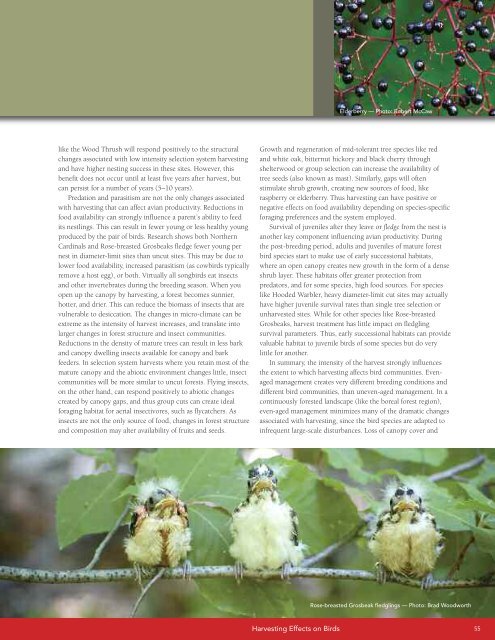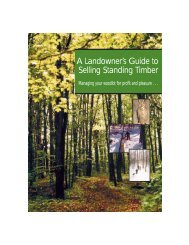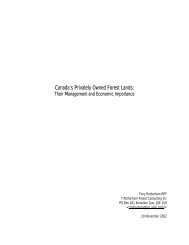A land manager's guide to conserving habitat for forest birds in ...
A land manager's guide to conserving habitat for forest birds in ...
A land manager's guide to conserving habitat for forest birds in ...
You also want an ePaper? Increase the reach of your titles
YUMPU automatically turns print PDFs into web optimized ePapers that Google loves.
Elderberry — Pho<strong>to</strong>: Robert McCaw<br />
like the Wood Thrush will respond positively <strong>to</strong> the structural<br />
changes associated with low <strong>in</strong>tensity selection system harvest<strong>in</strong>g<br />
and have higher nest<strong>in</strong>g success <strong>in</strong> these sites. However, this<br />
benefit does not occur until at least five years after harvest, but<br />
can persist <strong>for</strong> a number of years (5–10 years).<br />
Predation and parasitism are not the only changes associated<br />
with harvest<strong>in</strong>g that can affect avian productivity. Reductions <strong>in</strong><br />
food availability can strongly <strong>in</strong>fluence a parent’s ability <strong>to</strong> feed<br />
its nestl<strong>in</strong>gs. This can result <strong>in</strong> fewer young or less healthy young<br />
produced by the pair of <strong>birds</strong>. Research shows both Northern<br />
Card<strong>in</strong>als and Rose-breasted Grosbeaks fledge fewer young per<br />
nest <strong>in</strong> diameter-limit sites than uncut sites. This may be due <strong>to</strong><br />
lower food availability, <strong>in</strong>creased parasitism (as cow<strong>birds</strong> typically<br />
remove a host egg), or both. Virtually all song<strong>birds</strong> eat <strong>in</strong>sects<br />
and other <strong>in</strong>vertebrates dur<strong>in</strong>g the breed<strong>in</strong>g season. When you<br />
open up the canopy by harvest<strong>in</strong>g, a <strong>for</strong>est becomes sunnier,<br />
hotter, and drier. This can reduce the biomass of <strong>in</strong>sects that are<br />
vulnerable <strong>to</strong> desiccation. The changes <strong>in</strong> micro-climate can be<br />
extreme as the <strong>in</strong>tensity of harvest <strong>in</strong>creases, and translate <strong>in</strong><strong>to</strong><br />
larger changes <strong>in</strong> <strong>for</strong>est structure and <strong>in</strong>sect communities.<br />
Reductions <strong>in</strong> the density of mature trees can result <strong>in</strong> less bark<br />
and canopy dwell<strong>in</strong>g <strong>in</strong>sects available <strong>for</strong> canopy and bark<br />
feeders. In selection system harvests where you reta<strong>in</strong> most of the<br />
mature canopy and the abiotic environment changes little, <strong>in</strong>sect<br />
communities will be more similar <strong>to</strong> uncut <strong>for</strong>ests. Fly<strong>in</strong>g <strong>in</strong>sects,<br />
on the other hand, can respond positively <strong>to</strong> abiotic changes<br />
created by canopy gaps, and thus group cuts can create ideal<br />
<strong>for</strong>ag<strong>in</strong>g <strong>habitat</strong> <strong>for</strong> aerial <strong>in</strong>sectivores, such as flycatchers. As<br />
<strong>in</strong>sects are not the only source of food, changes <strong>in</strong> <strong>for</strong>est structure<br />
and composition may alter availability of fruits and seeds.<br />
Growth and regeneration of mid-<strong>to</strong>lerant tree species like red<br />
and white oak, bitternut hickory and black cherry through<br />
shelterwood or group selection can <strong>in</strong>crease the availability of<br />
tree seeds (also known as mast). Similarly, gaps will often<br />
stimulate shrub growth, creat<strong>in</strong>g new sources of food, like<br />
raspberry or elderberry. Thus harvest<strong>in</strong>g can have positive or<br />
negative effects on food availability depend<strong>in</strong>g on species-specific<br />
<strong>for</strong>ag<strong>in</strong>g preferences and the system employed.<br />
Survival of juveniles after they leave or fledge from the nest is<br />
another key component <strong>in</strong>fluenc<strong>in</strong>g avian productivity. Dur<strong>in</strong>g<br />
the post-breed<strong>in</strong>g period, adults and juveniles of mature <strong>for</strong>est<br />
bird species start <strong>to</strong> make use of early successional <strong>habitat</strong>s,<br />
where an open canopy creates new growth <strong>in</strong> the <strong>for</strong>m of a dense<br />
shrub layer. These <strong>habitat</strong>s offer greater protection from<br />
preda<strong>to</strong>rs, and <strong>for</strong> some species, high food sources. For species<br />
like Hooded Warbler, heavy diameter-limit cut sites may actually<br />
have higher juvenile survival rates than s<strong>in</strong>gle tree selection or<br />
unharvested sites. While <strong>for</strong> other species like Rose-breasted<br />
Grosbeaks, harvest treatment has little impact on fledgl<strong>in</strong>g<br />
survival parameters. Thus, early successional <strong>habitat</strong>s can provide<br />
valuable <strong>habitat</strong> <strong>to</strong> juvenile <strong>birds</strong> of some species but do very<br />
little <strong>for</strong> another.<br />
In summary, the <strong>in</strong>tensity of the harvest strongly <strong>in</strong>fluences<br />
the extent <strong>to</strong> which harvest<strong>in</strong>g affects bird communities. Evenaged<br />
management creates very different breed<strong>in</strong>g conditions and<br />
different bird communities, than uneven-aged management. In a<br />
cont<strong>in</strong>uously <strong>for</strong>ested <strong>land</strong>scape (like the boreal <strong>for</strong>est region),<br />
even-aged management m<strong>in</strong>imizes many of the dramatic changes<br />
associated with harvest<strong>in</strong>g, s<strong>in</strong>ce the bird species are adapted <strong>to</strong><br />
<strong>in</strong>frequent large-scale disturbances. Loss of canopy cover and<br />
Rose-breasted Grosbeak fledgl<strong>in</strong>gs — Pho<strong>to</strong>: Brad Woodworth<br />
Harvest<strong>in</strong>g Effects on Birds 55

















